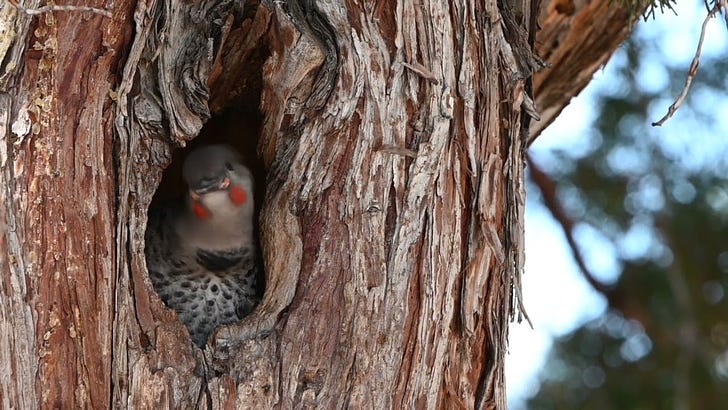Yesterday I met this juvenile red-shafted Northern Flicker in the high desert of Oregon.
Flickers are common, but like all life on Earth, they are in danger. Bird populations around the world are collapsing. Even "common" species like the American Robin have seen massive population declines because of habitat destruction, insect population collapse, housecats, and other human impacts.
Flickers are not safe. They face all these impacts. This tree is a Western Juniper, one of several Juniper species who are being clearcut en masse across Oregon, Idaho, Nevada, California, Wyoming, and Montana. Ironically, this is not for lumber or even firewood, but because of a misguided attempt at "restoration" of water cycles which have been harmed by overgrazing, overpumping, and more and more human impacts. People are arguing that cutting down the forest will mean more water available for humans. It's insane.
These trees are also being cut down to supposedly help the Greater Sage-Grouse, another bird species which has lost 98% of it's population. The Sage-Grouse is mostly being harmed by habitat destruction for ranching, mining, oil and gas exploration, urban sprawl, as well as increasing wildfires (about 90% of wildfires are caused by humans). Vast forests of native Juniper and Pinyon Pine trees, some of them hundreds of years old, are being cut down in the name of this "restoration." The trees are being scapegoated, and the birds who rely on them will go as they do. Already, the Pinyon Jay (who are symbiotic with Pinyon Pine trees) is experiencing massive population crashes — more than 90% — as their forests are destroyed.
There are many other threats to Flickers. As I mentioned, insect populations are crashing, and they are the main food source for Flickers. Like Orca whales starving as salmon populations go extinct, the Flickers will go as the insects go.
Industrial civilization is driving a mass extermination of life, turning forests into fields into deserts, creating hundreds of oceanic dead zones in seas vacuumed of fish by vast trawlers, and destabilizing the climate. It's a moral imperative for us to take action to stop this.





The horror just doesn't end.